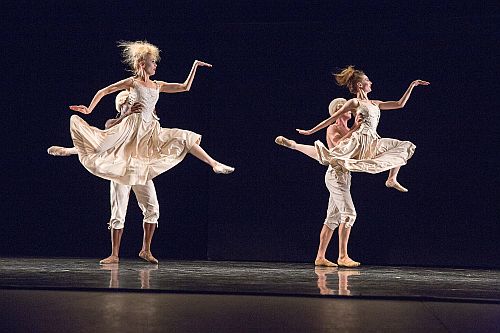 United States Balanchine, Limón, Kylián: Los Angeles Ballet, Royce Hall, Los Angeles, 6.6.2015 (JRo)
United States Balanchine, Limón, Kylián: Los Angeles Ballet, Royce Hall, Los Angeles, 6.6.2015 (JRo)

George Balanchine: Tchaikovsky Piano Concerto No. 2
Jose Limón: The Moor’s Pavane
Jiři Kylián: Sechs Tänze (Six Dances)
If Fred Astaire embodied the essence of dance to George Balanchine, then surely, for Jiři Kylián, as evidenced in his hilarious yet knowing ballet, Sechs Tänze, it’s Charlie Chaplin and his comic physical grace that spring to mind. Los Angeles Ballet wisely chose Kylián’s creation to conclude its triple bill, entitled Director’s Choice, along with Balanchine’s Tchaikovsky Piano Concerto No. 2 and Limón’s The Moor’s Pavane.
Set to some of Mozart’s German dances, Sechs Tänze is an absolute confection, a paean to nonsense in a world perpetually ravaged by strife. The dancers of LAB were at their unbridled best, expertly conveying the dance’s humor and pathos. When physical comedy is mingled with grace and athleticism, it’s a perfect marriage of forms – evident in the balletic movements of Chaplin in his films.
The piece is set in a whimsical, courtly world, as evidenced by powdered wigs and spare eighteenth-century costumes, and is alive with the antic movements of children at play. Dancers create human yo-yos and mimic rag dolls, and soap bubbles drift overhead. Invention abounds in each of the six dances. Bewigged male dancers encased in enormous bell-like ball gowns appear to glide effortlessly, self-driven, across the floor. There are apples speared with swords, wobbling heads that shake off puffs of powder, and mock beheadings. It’s a joyous romp from beginning to end, and a piece that shows off the talents of LAB’s dancers.
Limón’s The Moor’s Pavane is also a solid addition to the company’s repertory. A distillation of Shakespeare’s Othello, the ballet is a theatrical abstraction of the play and a landmark of mid-twentieth-century modern dance, created for four dancers representing Othello, Desdemona, Iago, and his wife, Emilia. On a stark black stage with the quartet costumed in Renaissance finery, the scheming of Iago and Emilia, the tortured jealousy of Othello, and the subsequent murder of Desdemona play out to a score derived from Purcell excerpts, arranged by Simon Sadoff. Within the stately measures of sixteenth-century Renaissance court dance, the principals ceremoniously begin to move in a circle, obeying the polite codes of patrician behavior, but fate awaits and hangs heavily over the dance. Eventually violence, precipitated by Iago with the complicity of Emilia, erupts, and it ends in the inevitable tragedy of Desdemona’s death.
The Moor’s Pavane is as much about acting as it is about dance. Zheng Hua Li as Othello understands the character but is hampered by the disparity in size between him and the 6’4″ Erik Thordal-Christensen. It is in the squaring off of these two men that the dance derives much of its drama. Thordal-Christensen, a graceful young dancer, towers over his rival. The men should stand eye to eye as they cock their heads and flick their torsos in psychological combat. Thordal-Christensen’s Iago feels a bit young and unformed – when he clings to Othello’s back in a snake-like grip, one thinks more of a malevolent teenager than the mature instigator of Othello’s destruction.
Allyssa Bross proves an elegant Desdemona. Bianca Bulle dances Emilia with fire but with more coyness and seductiveness than the role asks for. It is the violence and treachery bursting through the courtly restraint of these characters that creates the tension and drives the dance forward.
The most problematic piece of the evening is the first on the program: Balanchine’s Tchaikovsky Piano Concerto No. 2, created in 1941 for Ballet Caravan and originally titled Ballet Imperial. Conceived as an homage to Petipa, the father of classical ballet, Balanchine revived it in 1964 for New York City Ballet and subsequently restaged the work in 1973. It is a resplendent tribute to the grand Russian style.
One wishes for the time when LAB can command a hall of its own and musicians in the pit. Without an orchestra and pianist to accompany the grandeur of this exacting ballet, a flatness results that no amount of goodwill and enthusiasm on the part of the dancers can overcome. It is particularly with Tchaikovsky’s ballet scores and orchestral works (one should also include Prokofiev – the other great composer for dance) that the lack of live music seems to hamper the dance. Ballet, like opera, is a dialogue between orchestra and performer. Without this interaction, dancers are merely dancing to the music, rather than inhabiting it.
Despite this, Allynne Noelle is a sparkling and assured presence. As her cavalier, Ulrik Birkkjaer is princely and compelling. And the third principal, Julia Cinquemani ̶ in a role that Colleen Neary, co-director of LAB, originated in the 1973 restaged version ̶ dances with a robust musicality.
Given their mastery of Kylián’s Sechs Tänze and the obvious delight they took in executing it, one hopes to see the dancers of LAB perform more of Kylián’s work in the future, along with their established repertory of Balanchine and Bournonville.
Jane Rosenberg